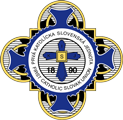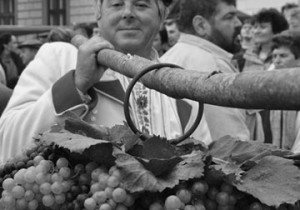My previous articles discussed the harvest (žatva) and harvest festivals (dožinky). Another crop that was harvested were grapes, and Vinobranie was the celebration which took place once the grapes were picked and the first wines tasted.
When I was younger, I never knew that wines even came from Slovakia. I first came into contact with Slovak wines and the Vinobranie when I was living in Bratislava in 1982. A good friend of mine from Vajnory, a village on the northern tip of Bratislava, invited to taste his own fine homemade white wine and then attend the wine festival there. The festival featured wine-tasting, various amusements, and live entertainment with Slovak singing and dancing.
Why did we not know of Slovak wines in America? Many Slovak-Americans came from the poorer regions of eastern and northern Slovakia where wine was not a
staple drink. There slivovica (plum brandy) and hard liquors were more popular, so many of us never tasted a Slovak wine in the New World. But even my Slovak maternal grand-father had his grapevines, but we mainly ate those grapes.
Most Slovak wines are consumed in Slovakia itself or nearby countries and very little is exported; in the post-World War II era, the communist regime made any trade with the West difficult. Even after the Velvet Revolution of 1989, Slovak wineries expanded, but most sales remained regional. Only the very sweet and thicker Tokaj wine of south-eastern Slovakia and northeast Hungary are exported and more well known. But many of the Slovak producers prefer to make it the old-fashioned way, which limits the quantity, but keeps the quality higher.
Wine-Producing Regions
Today Slovakia claims around 400 active winemakers cultivating 19,634 hectares (48,516 acres) of vineyards in 603 municipalities, 40 sub-regions, and 6 main wine regions (see map). With the exception of Orava, some wine-producing grapes are grown throughout Slovakia. The largest wine producing areas are north of Bratislava and south of Košice, in areas where the weather is warmer and the climate hospitable to grape growing.
There are 6 regions which produce wine in Slovakia.
Malokarpatská – “The Small Carpathian wine region”
Južnoslovenská – “The South Slovak wine region”
Nitrianska – “The Nitra wine region”
Stredoslovenská – “The Central Slovak wine region”
Východoslovenská – “The East Slovak wine region”
Tokajská – “The Tokaj wine region”
Varieties of Wines
The most popular wines in Slovakia are following.
Veltlínské zelené (Grüner Veltliner) – White
Rizling vlašský (Welschriesling) – White
Frankovka modrá (Blaufränkisch) – Red
Müller-Thurgau – White
Svätovavrinecké (St. Laurent)
Rulandské biele (Pinot Blanc)
Rizling rýnsky (Riesling)
Cabernet Sauvignon – Red
A Brief History of Slovak Wines
Viticulture in Slovakia enjoys a long history, mainly in southwestern and southeastern Slovakia. Research by archaeologists from the Slovak Academy of Sciences during the 1960s and 1970s found vineyard knives and a clay wine jug dating from Celtic times during the 6th-7th centuries in the area above Smolenice, around 53 km north of Bratislava. Wine-growing expanded under the Romans during the 2nd century A.D. and continued after the arrival of Slavs in the 6th-7th centuries.
Byzantine histories referred to vineyards in the area during of Slavic–Avar wars during the migration. Apparently, a Bulgarian tsar ordered that all vineyards be uprooted when one of his soldiers reported his Avar governor having bouts of drunkenness. The vine-yards rebounded afterwards and records indicate their existence during Great Moravian Empire. Three Old Slavonic prayers date from this era: a prayer when planting a vine-yard, a grape harvesting prayer, and one for the proper fermentation of wine.
It appears that wine-growing continued until Tatar invasions of 1241–1242, which destroyed many of the vineyards. Wine producing recovered when the King of Hungary invited German and Italian colonizers, and Italians settled in the eastern Tokaj region. Most German wine growers settled near Bratislava, and the Danube River facilitated a lively trade. A number of Austrian and Hungarian writers noted the high quality of grapes and white wines produced in the region, on the foothills of the Low Carpathian Mountains. By the late 15th century, wine-growing guilds started up and the skills passed from generation to generation. Wine growers had to pay town councils and local lords with part of their production. And we know that the prosperous Fugger family from Augsburg, Germany and noble Thurzov family built wine cellars at Červený Kameň (the Red Stone Castle).
Historical records from the 18th century cited the production of sweet wines production, including a Vermouth type and a rose wine from blue grapes. Villages near Bratislava (Rača, Vajnory, Svätý Jur, and Grinava) produced a prized samotok wine (a juice extract from grapes), and chronicler Matej Bel (1684 – 1749) mentioned a quickly maturing variety called Viridula. Other wines could take as long as 3 to 4 years to mature.
During the 19th century, wine production continued to grow in areas north of Bratislava. For instance, in 1824, Anton Walza, a vintner from Trnava, supplied wine for the Hungarian Army. In 1825, one of Napoleon’s soldiers, J. E. Hubert, established in Slovakia the first production site of champagne wines outside the France.
Viticulture in Slovakia declined in the early 20th century due to severe frosts, fungal diseases (perenospora), and phylloxera, a microscopic louse or aphid, that lives on and eats roots of grapes, which destroyed as much as 97 % of European vineyards. Wine-producing gradually got back on track in the interwar era, and had to compete with foreign sweet wines.
Vineyards started to expand again after the communist takeover of 1949. Forced collectivization led to the construction of large processing facilities in the now state-owned cooperative enterprises. As a result production of wine doubled, but quality suffered. Producing a third more than it needed for domestic consumption, Slovakia exported wine to the Soviet Union and to the Czech lands.
Following the Velvet Revolution of 1989, Slovak winemakers returned to old traditions which stressed quality over quantity. New companies and entrepreneurs started to realize the potential for marketing a better product. The 2004 admission of Slovakia into the EU opened its borders to new competition, so the stress on a quality product became ever more important.
Recently, Slovak wines have increasingly received widespread acclaim and won a number of international competitions. Slovak wines won 18 gold and 37 silver medals at the Viniales Internationales 2016 competition in Paris and more awards at competitive contests in Madrid and Tokyo. The emphasis on quality wine producing has begun to pay off.
Wine Festivals in History
Wine festivals have a long history in Western Civilization dating back to the time of the Ancient Greeks. While the Egyptians had honored their god Osiris as the patron of wine, the Greek celebrations to Dionysus, the god of wine, are the oldest historically documented festivals. They usually involved drinking, grape pressing, consuming regional foods, jovial music and some religious rituals.
The Romans heavily borrowed from the Greeks in celebrating their Bacchanalia, the festivals of Bacchus. Starting around 200 BC, these popular feasts took place throughout central and southern Italy peninsula. While we know little about the rites during Bacchanalia, the Roman historian Livy believed them as contributing to the decline of the Empire. He portrayed them as corrupt, cultish, conspiratorial, scandalous and full of wild frenzy and sexual debauchery. He associated them with the mystery cults of Rome which were threatening traditional religion and political stability in the second century A.D. In one instance, he wrote that the state arrested 7,000 participants, and executed the majority of them!
This did not stop the wine festival tradition, and they continued after Rome fell. During the Middle Ages, wine celebrations spread throughout other parts of Europe, and became especially popular in France, Germany, Spain, Hungary, and elsewhere. Today one can find grape harvest festivals throughout the world, from Australia to Argentina and the USA.
Traditional Vinobrania in Slovakia
The Vinobrania or Wine Festivals have a long history in Slovakia and usually occur in late September. The oldest one in Pezinok and dates as far back to the 13th century, but we have just a few details about those. During the Great Depression, the celebrations took place mainly in the wine cellars themselves, but today it has become a big event that has moved above ground.
For the most part, Vinobrania, the traditional feast accompanying the harvest of grapes, is a 20th century phenomena in Slovakia. During the interwar era, wealthy wine growing families hired their vintner workers to decorate a wreath with ribbons and flowers and the vintage wagon with the last-picked grapes. Similar to the Slovak harvest festivals, a parade route with people dressed in traditional folk dress (kroj) took a procession from the vineyard to the town, accompanied by singing. The participants carried a wreath (veniec) from the most beautiful vines to the owner of that prize vines. The winemaker’s family prepared their yard for a feast to feed and entertain their vine workers. After a series of speeches, a sumptuous meal for all would typically include tasty meats, roast chicken, bread, and pastries. Merri-ment would follow with wine drinking, singing and music.
The first well-recorded wine festival in Slovakia occurred in 1934 on the feast of St. Václav (September 28) and continued the following year. The city council in Pezinok organized the event in cooperation with the vineyard guilds, the State Railways, and several municipal corporations. They used the Vinobrania not only to celebrate but to promote the local wines. After this successful event, several neighboring wine-growing towns (Modra and Svätý Jur) mimicked the custom.
The custom declined shortly after and the Second World War did away with any such celebrations. Pezinok attempted to revive the grape harvest on October 13, 1946. Government officials and journalists from Prague attended the ceremonies, and Czechoslovak Radio broadcast the events to publicize them.
The expansion of the festival continued several years later after the communists compelled the formation of the agricultural cooperatives. District authorities decided that the celebrations would be held on alternate weekends in the two largest wine-growing towns of the Small Carpathian region, Pezinok and Modra. In 1958, one of the biggest events coincided with the celebration of the 800th anniversary of the founding of Modra. More than 30,000 visitors attended.
A second vinobranie took place in Pezinok in 1959, and also coincided with commemorating the 15th anniversary of the anti-Nazi Slovak National Uprising of 1944. The communists used the event to showcase the progress of their agricultural production and machinery. Over 40,000 visitors came, including many from Bohemia and Moravia. The event expanded into a large cooperative fair in which hundreds of stalls sold all sorts of goods, including engraved cups, foods, wine, and even geese.
As many as 250 different wines were available for tasting, including the famous burčiak, a young, fermenting wine. A Slovak legend relates that every man should replace his blood every year by drinking two liters of burčiak. Since burčiak is only available only in the autumn for a few weeks, it became “the drink of choice” at any Vinobranie.
Vinobrania today
Located just 20 km northeast of Bratislava, Pezinok is an ideal place to make a day-trip when visiting the Slovak capital. In 2016, the Pezinok Vinobranie took place on the weekend of September 18-20 and featured the tantalizing tasting of locally produced young wines and plenty of live entertainment and concerts. One may combine wine trials with full meals featuring traditional Slovak foods such as cigánska (grilled pork or chicken with mustard and onion), roast goose (pečený hus), sausages (klobasy), lokša (potato dough pancakes), and or the famous trdelník, a sweet pastry made from rolled dough that is wrapped around a stick, then grilled and topped with sugar and walnut mix.
Here is an example of many programs offered at the 2016 Pezinok grape harvest festival. Festivities began at 5 pm on Friday with the first toast marking the commencement of the festivities. After a fanfare by the group Funny Fellows, there was blessing of the harvest, following by a parade from the castle to the wine shop at the town square. After some speeches at the town hall, there was a performance by the folklore group SS BIRCH, followed by the Sunny Dance group from Pezinok. Entertainment continued until 10 pm with music by Funny Fellows, Fleret from the Czech Republic, and an Abba Revival band. Similar music took place at the foot of the castle at the same time, which included a Country Music Band, other folk music, and even a group (Poa pratensis) from Hungary performing.
The program continued on Saturday at the Grandstand at the town hall as well as in front of the castle. At the town hall, the Music School Eugen Suchoň of Pezinok put on the first live show followed by the Bon Bon Trio, MC Erik, Viva Italia from the Czech Republic, and the Pressburger Klezmer Band. In the evening, a Queen Revival group performed, finished off with fireworks and several more modern bands playing until 10 pm.
Sunday events included another parade and a prevalence of brass band performances, including a group from Norway and some Cuban Salsa dancing. The program intended to have something for everyone, far beyond just a celebration of wine.
If one did not have the opportunity to go to Pezinok or the nearby towns, Bratislava itself held its own celebration in the center of the Old Town without the benefit of adjacent vineyards. In eastern Slovakia, Košice has hosted its own wine festival since 2007. It includes an array of Slovakia’s best grape-growers and winemakers as well as selected foreign winemakers. The Košíce event highlights the fine tasting wines from the Tokaj, Eger and eastern Slovakia. The festival includes a schedule of educational events, guided tasting sessions, lectures and workshops.
So in contemporary Slovakia, Vinobrania are annual events that have transformed into huge fairs including far more than just parading the local wines and celebrating the grape harvest. They provide a welcome release from the work week and promote traditional Slovak folk song and dance, but also have expanded to include more modern music and entertainment to attract all generations and people with diverse interests. The original concept of a wine festival has persisted, but has expanded far beyond just an interest in grapes and fine wines.



